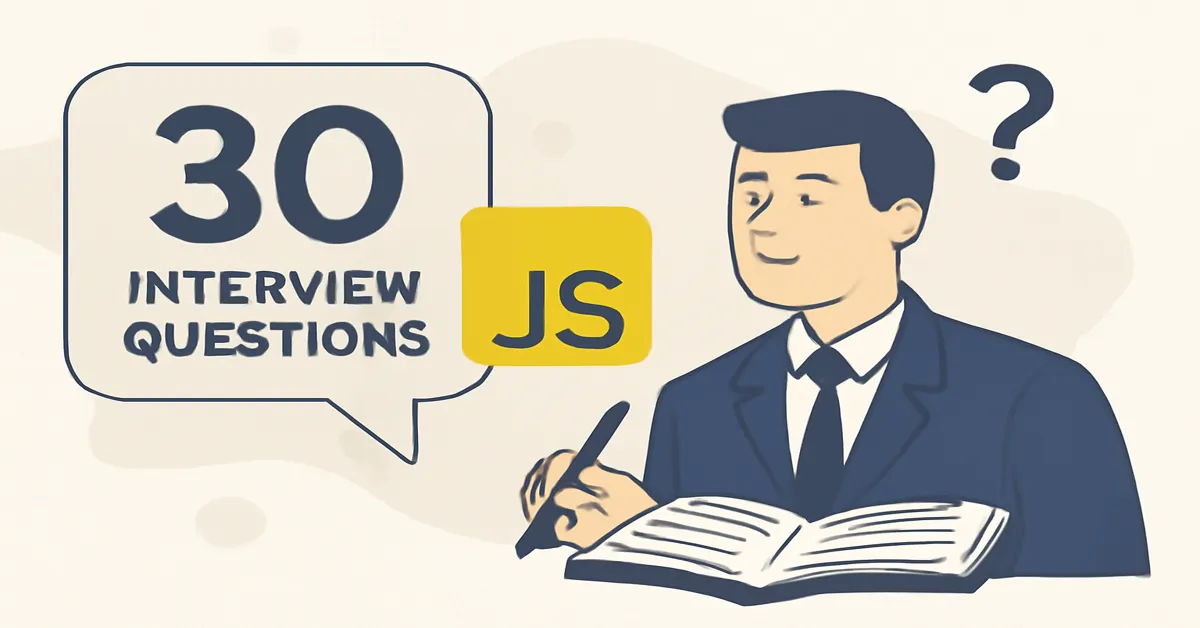JavaScript has become one of the most important languages for developers, especially in the world of web development. It powers dynamic, interactive websites and has been adopted for both front-end and back-end development. If you’re preparing for a JavaScript interview, you may face a variety of questions that test your knowledge, understanding of key concepts, and ability to apply JavaScript in real-world scenarios.
In this article, we have compiled 30 interview questions that cover a wide range of topics, from basic concepts to more advanced topics like closures, asynchronous programming, and JavaScript frameworks. Whether you’re a beginner or an experienced developer, these questions will help you get ready for your next JavaScript interview and test your knowledge.
Let’s break down these questions into different categories for better clarity: basic concepts, advanced topics, technical challenges, and practical scenarios. Understanding the answers to these questions will help solidify your understanding of JavaScript and demonstrate your proficiency in the language.
1. Basic JavaScript Concepts
1. What is JavaScript?
JavaScript is a high-level, interpreted programming language primarily used for building interactive web pages. It runs on the client-side, meaning it executes in the user’s browser. JavaScript allows web pages to respond to user input, manipulate the DOM (Document Object Model), and interact asynchronously with external data.
2. What is the difference between var, let, and const?
var: The traditional way of declaring variables in JavaScript. It has function-level scope and is hoisted to the top of its function.let: Introduced in ES6,letprovides block-level scope, meaning it is only available within the block in which it is defined.const: Also introduced in ES6,constis used to define constant values, and likelet, it has block-level scope. The value assigned to aconstcannot be changed after initialization.
3. What are JavaScript data types?
JavaScript has several built-in data types:
- Primitive types:
undefined,null,boolean,number,string,symbol, andbigint. - Reference types:
object, including arrays, functions, and date objects.
4. What is the difference between null and undefined?
null: A special value representing the intentional absence of any object value. It is often used to indicate that a variable should have an object or reference type.undefined: Indicates that a variable has been declared but has not been assigned any value. It is the default value of uninitialized variables.
5. What is hoisting in JavaScript?
Hoisting is a JavaScript mechanism where variables and function declarations are moved to the top of their respective scopes during the compile phase. However, only the declarations are hoisted, not the assignments. For example, a var declaration is hoisted, but its value is not initialized until the line of code is executed.
2. Intermediate JavaScript Concepts
6. What are closures in JavaScript?
A closure is a function that retains access to its lexical scope, even when the function is executed outside of that scope. This means a closure can remember variables from its containing function, even after the outer function has finished executing.
Example:
javascriptCopyfunction outer() {
let count = 0;
return function inner() {
count++;
console.log(count);
};
}
const counter = outer();
counter(); // 1
counter(); // 2
7. What is the this keyword in JavaScript?
The this keyword refers to the context in which the function is called. Its value depends on how the function is invoked:
- In global scope:
thisrefers to the global object (windowin browsers). - In an object method:
thisrefers to the object itself. - In a constructor function:
thisrefers to the newly created instance.
8. What are arrow functions and how do they differ from regular functions?
Arrow functions were introduced in ES6 and provide a shorter syntax for defining functions. The key difference is that arrow functions do not have their own this context; instead, they inherit this from the surrounding context.
Example:
javascriptCopyconst add = (a, b) => a + b;
9. What are JavaScript promises?
A promise is an object that represents the eventual completion (or failure) of an asynchronous operation. Promises are used to handle asynchronous code in a more manageable way, avoiding callback hell. Promises have three states: pending, fulfilled, and rejected.
Example:
javascriptCopylet promise = new Promise((resolve, reject) => {
let success = true;
if (success) {
resolve("Operation successful");
} else {
reject("Operation failed");
}
});
promise.then(result => console.log(result)).catch(error => console.log(error));
10. What is event delegation in JavaScript?
Event delegation is a technique where you attach a single event listener to a parent element, rather than individual child elements. This approach improves performance and makes it easier to manage events for dynamically added elements.
Example:
javascriptCopydocument.querySelector('#parent').addEventListener('click', function(event) {
if (event.target && event.target.matches('button')) {
console.log('Button clicked!');
}
});
3. Advanced JavaScript Topics
11. What is the event loop in JavaScript?
The event loop is a fundamental concept in JavaScript that allows the execution of asynchronous code. It constantly checks the call stack and the callback queue. When the call stack is empty, it pushes the first callback in the queue to the stack for execution.
12. What is the difference between synchronous and asynchronous programming in JavaScript?
- Synchronous programming executes code line-by-line, blocking the execution of subsequent code until the current task is completed.
- Asynchronous programming allows tasks to run in parallel, letting other code run while waiting for a task (like a network request) to finish. This is typically handled through callbacks, promises, or async/await.
13. What are higher-order functions in JavaScript?
Higher-order functions are functions that can take other functions as arguments, return functions, or both. They are a core concept in functional programming and allow you to create more abstract and reusable code.
Example:
javascriptCopyfunction greet(name, callback) {
console.log("Hello, " + name);
callback();
}
greet("John", function() {
console.log("How are you?");
});
14. What is the difference between call(), apply(), and bind() in JavaScript?
call(): Invokes a function with a specifiedthisvalue and arguments passed individually.apply(): Similar tocall(), but arguments are passed as an array.bind(): Returns a new function that, when called, has the specifiedthisvalue and initial arguments.
15. What is a JavaScript module?
A JavaScript module is a way to structure and organize code by breaking it into separate files. Modules allow you to export and import functions, objects, or variables, making the code more reusable and maintainable. ES6 introduced import and export statements to enable modularization in JavaScript.
Example:
javascriptCopy// math.js
export function add(a, b) {
return a + b;
}
// app.js
import { add } from './math.js';
console.log(add(2, 3)); // Outputs: 5
4. Practical Coding Challenges
16. How do you reverse a string in JavaScript?
You can reverse a string in JavaScript using various methods, but one of the most common ways is to use the following method:
javascriptCopylet str = "Hello";
let reversed = str.split('').reverse().join('');
console.log(reversed); // Outputs: "olleH"
17. How do you check if an object is an array in JavaScript?
You can check if a variable is an array by using the Array.isArray() method:
javascriptCopylet arr = [1, 2, 3];
console.log(Array.isArray(arr)); // Outputs: true
18. How do you remove duplicates from an array in JavaScript?
One common approach to remove duplicates from an array is by using the Set object, which automatically removes duplicates:
javascriptCopylet arr = [1, 2, 2, 3, 4, 4];
let uniqueArr = [...new Set(arr)];
console.log(uniqueArr); // Outputs: [1, 2, 3, 4]
19. How do you convert a string to a number in JavaScript?
You can convert a string to a number using parseInt(), parseFloat(), or the unary + operator.
Example:
javascriptCopylet str = "123";
let num = +str;
console.log(num); // Outputs: 123
20. What is a promise chaining in JavaScript?
Promise chaining is the process of linking multiple .then() methods together to handle sequential asynchronous operations.
Example:
javascriptCopyfetch('https://api.example.com/data')
.then(response => response.json())
.then(data => console.log(data))
.catch(error => console.error(error));
5. Final Thoughts and Interview Preparation Tips
JavaScript is an essential language for modern web development, and mastering its core concepts is key to becoming a successful developer. The 30 interview questions covered in this article touch upon the fundamentals of JavaScript, as well as more advanced topics like closures, event handling, and promises.
As you prepare for interviews, it’s important to not only understand the theoretical concepts behind JavaScript but also to practice coding challenges that require you to apply these concepts in real-world scenarios. You can improve your understanding of JavaScript by writing code, experimenting with different frameworks, and continuously learning from resources like documentation, tutorials, and coding challenges.
With JavaScript remaining a critical part of both front-end and back-end development, your proficiency in this language will open up opportunities for web development, mobile app development, and even working with JavaScript-based server-side technologies like Node.js. Keep practicing, stay curious, and you’ll be well on your way to mastering JavaScript.
Conclusion:
Preparing for a JavaScript interview is about more than just memorizing answers—it’s about truly understanding the language, its nuances, and how to apply it effectively. By working through these questions and applying your knowledge, you’ll not only be ready for an interview but also prepared for the challenges you’ll face as a JavaScript developer.
Read:
What is JavaScript? A Beginner’s Guide to Understanding the Language
FAQs
1. What are the most important topics to study for a JavaScript interview?
For a JavaScript interview, focus on core concepts such as data types, loops, functions, closures, the this keyword, and event handling. Advanced topics like promises, async/await, and the event loop are also important. Additionally, familiarize yourself with common JavaScript frameworks and libraries, as well as practical coding challenges and problem-solving techniques.
2. How can I prepare for JavaScript coding challenges in interviews?
To prepare for JavaScript coding challenges, practice writing code for common algorithms and data structures (such as arrays, strings, and linked lists). Use platforms like LeetCode, HackerRank, or CodeSignal to tackle problems in JavaScript. Focus on writing clean, efficient code, and be ready to explain your thought process and approach during the interview.
3. What is the difference between let, const, and var in JavaScript?
let: A block-scoped variable declaration that allows reassignment.const: A block-scoped declaration for constants that cannot be reassigned after initialization.var: A function-scoped variable declaration, which is outdated in modern JavaScript due to issues with hoisting and scoping.
4. What is a closure in JavaScript, and how is it used?
A closure is a function that retains access to its lexical scope, even when it is executed outside that scope. Closures are useful for data encapsulation, creating private variables, and handling asynchronous code. For example, closures are used in event handlers and callback functions to remember the surrounding context.
5. How do promises work in JavaScript?
A promise in JavaScript represents the eventual completion or failure of an asynchronous operation. Promises have three states: pending, fulfilled, and rejected. The then() method is used to handle a successful result, while catch() handles errors. Promises allow for cleaner and more manageable asynchronous code, replacing callback functions.











